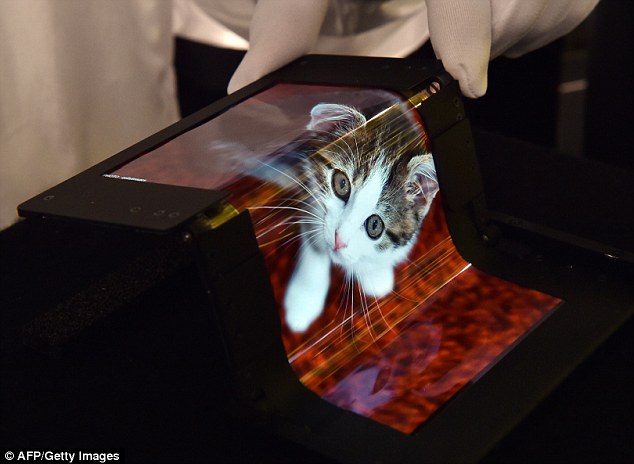Although it’s not quite common, flexible screens are making their way to the market and can be seen in a rising number of products nowadays. Samsung and LG might be the ones leading the charge, but Japan’s Semiconductor Energy Laboratory is also developing super-strong flexible screens. Recently, the firm demonstrated their latest breakthrough at an exhibition in Tokyo. It was a 5.9 inch display that allowed being bent for more than 100,000 times before it gets damaged.![]()
Organic light emitting diodes (OLED) are used in the foldable display which is made of layers of light. Touch sensors are included in these displays meaning the device works as a touchscreen at all angles and curvatures. This was demonstrated at the Display Innovation Exhibition in Yokohama. Images of landscapes, cats and peacocks were shown being bent and curved with the display, during the demonstration.
Similar to Samsung’s Galaxy Note Edge, these touchscreens will be curving over the edge of a handset. Galaxy Note Edge was unveiled by Samsung in September 2014. As the display is popping out of the phone, the touchscreen can still be used when its cover is closed. Notifications can be displayed at the top and bottom of the screen while viewing a video, so that playback is not disrupted.
The notifications and other icons appear on the right hand side of the curved edge. The Korean firm released the gadget as their second phone that featured curved display technology, following the Galaxy Round in October 2013.
LG’s G Flex phone featured a similar design, and both firms are pioneering curved TV’s. In July, LG introduced an 18-inch screen that can be rolled up, and it hopes to expand the technology to work on 60 inch displays in the future.
This OLED flexible panel hosts HD class resolution of 1200 x 810 with almost 1 million megapixels. One of the UK companies called Plastic Logic is developing a similar flexible screen technology and they revealed their own ‘paper tablet’ back in January 2013.
They recently formed a partnership with Cambridge Graphene Centre (CGC) to build a transistor featuring Graphene. A sheet of carbon atoms makes up Graphene. Graphene is the strongest, most lightweight and flexible material known and according to the firm, development of the screen “is a first step towards the wilder implementation of Graphene and Graphene-like materials into flexible electronics.”
The video of the device shows this display being cut with a pair of scissors, being bent and stood on, without the images on the display being affected. The prototype is known as an ‘active matrix electrophoretic display’. Similar screens to these are used in e-readers, but they are made of flexible plastic instead of glass. The difference between the traditional displays, the pixel electronics, or backplane of this display is marked by Graphene electrodes. These electrodes replay metal electrodes in other devices. Check out the youtube video below for more details:

